The string of 33 consecutive months of rent rising 0.4 percent or more is finally broken.
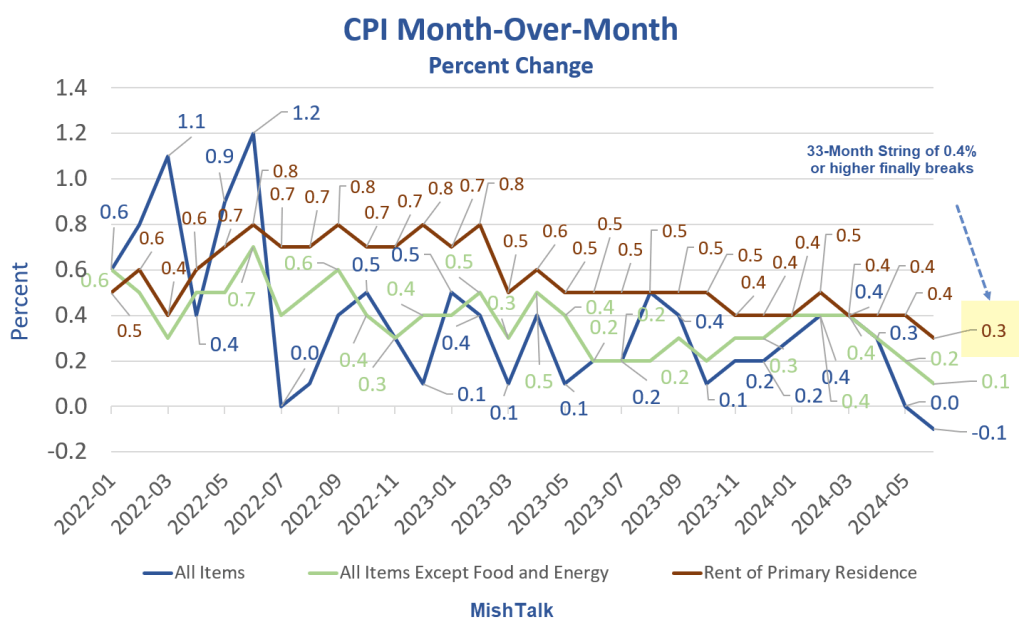
Month-Over-Month Synopsis
- CPI: -0.1 percent
- CPI excluding food and energy: +0.1 percent
- Rent: +0.3 percent
- Owners’ Equivalent Rent OER: +0.3 percent
- Food at Home: +0.1 percent
- Food Away From Home: +0.4 percent
- Medical Care Commodities: +0.2 percent
- Medical Care Services: +0.2 percent
- Energy: -2.0 percent
- Gasoline: -3.8 percent
Groundhog Day Ends at 33 Months
Owners’ Equivalent Rent (OER) is the single highest component in the CPI with a weight of 26.69 percent. OER is the price one would pay to rent their hose if they did not own it.
Rent of primary residence has a weight of 7.62 percent.
Both broke a string of 33 consecutive months of rising at least 0.4 percent. We are now likely to see a string of months where 0.3 percent is the high, not the low.
I expected rent moderation to start last month, my comments then:
This marks the 33rd consecutive increase of at least 0.4 percent for both.
I expected a flat CPI this month with rent and OER pulling back a bit. Had they fallen, we would have had a negative CPI.
The “rents are falling” (or soon will) projections have been based on the price of new leases and cherry picked markets. But existing leases, much more important, keep rising.
Only 8 to 9 percent of renters move each year. It’s been a huge mistake thinking new leases and finished construction would drive rent prices.
Most leases renew in May through August. I expect rent to moderate soon.
For over two years, analysts expected rents to moderate. I was not in that camp until last month, based on timing of leases.
Moderate, in context, means the rate of increase in rents.
Food Away From Home a Sore Spot
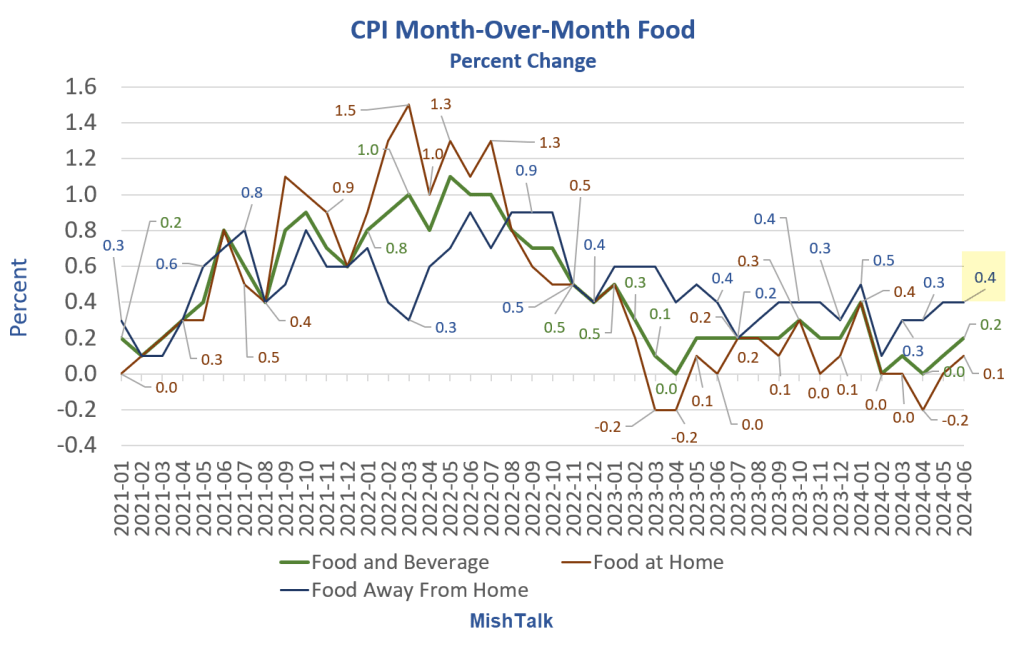
Food away from home rose another 0.4 percent. Food at home rose 0.1 percent.
The good news regarding the price of food is likely over. There never was much good news on food away from home.
Food at home is more important. It has a CPI weight of 8.05 percent vs food away from home at 5.34 percent.
Expect more people to shun eating out. But if wholesale prices rise, as I expect, restaurants will be limited in how they can attract business.
McDonalds bargain meals are not a bargain to say the least. The price of flavored coffee is absurd, and expected tips are ridiculously out of hand.
CPI Month-Over-Month Energy and Gasoline
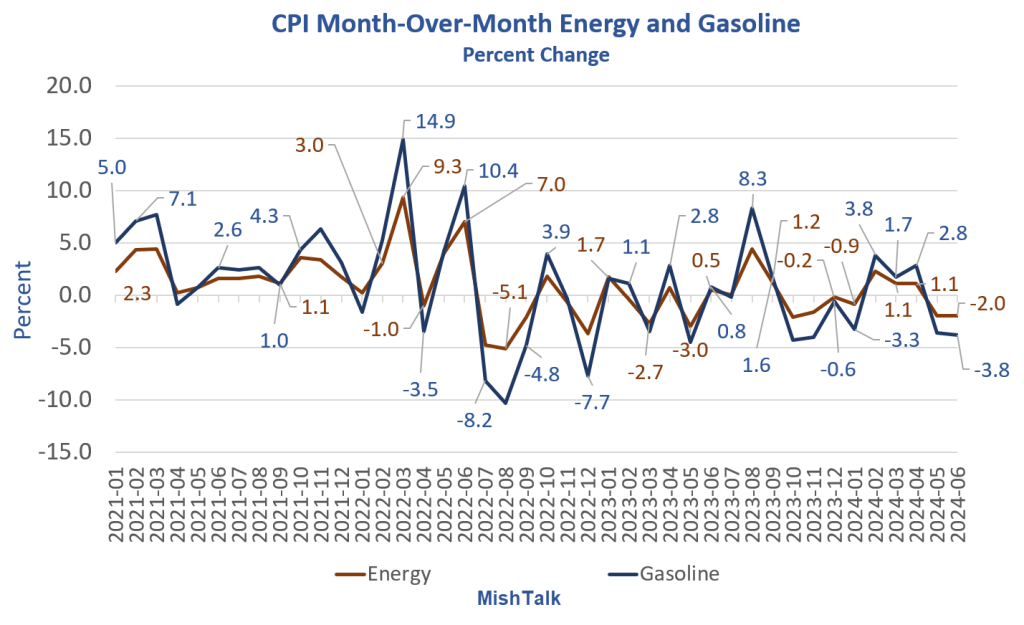
Good news on the energy front was universally expected. Economists have figured out how to read AAA gasoline prices.
Energy is 7.00 percent of the CPI. Gasoline is just over half of energy at 3.65 percent.
Unless there is a flare up in the Mideast, a slowing economy rates to cool the energy component of the CPI.
CPI Year-Over-Year Percent Change
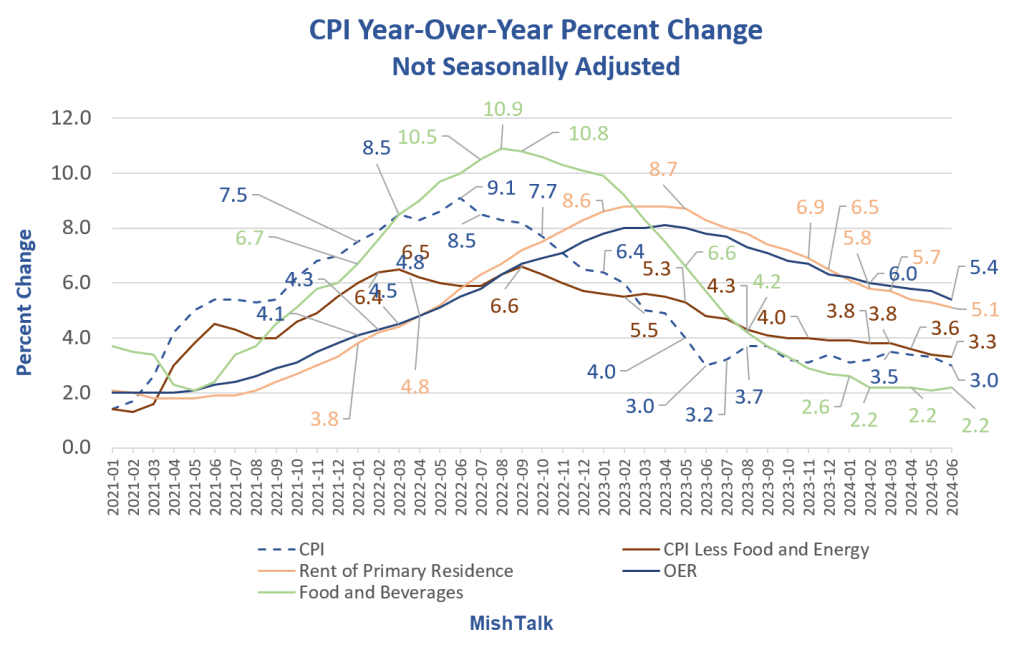
Year-Over-Year Numbers
- CPI: 3.0 Percent
- CPI excluding food and energy: 3.3 Percent
- Food and Beverages: 2.2 percent
- Rent: 5.1 percent
- OER: 5.4 Percent
- Energy: 1.0 Percent, not shown because immense volatility distorts the chart.
CPI Year-Over-Year Percent Change Medical Care
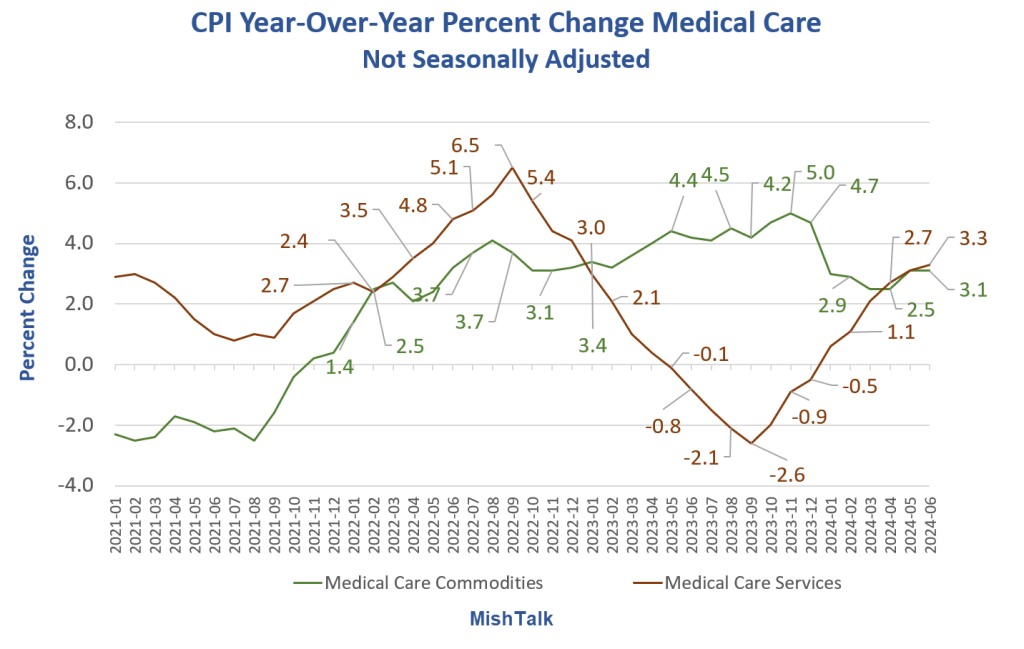
Medical care commodities are up 3.1 percent from a year ago. Medical care services are up 3.3 percent from a year ago.
With aging boomers and their increasing need for services, I expect this to become a major issue.
Medical care rates to put upward pressure on the CPI.
CPI Year-Over-Year Percent Change Food
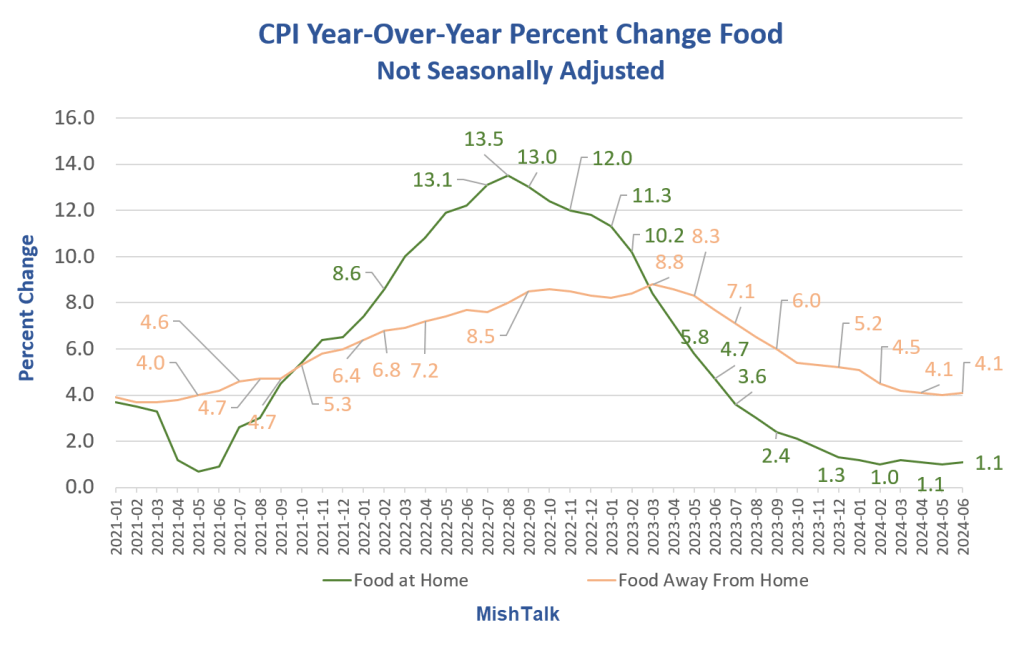
Food at home is up 1.1 percent from a year ago. Food away from home is up 4.1 percent from a year ago.
I believe both are going to put upward pressure on the CPI.
CPI and PCE Year-Over-Year Percent Change
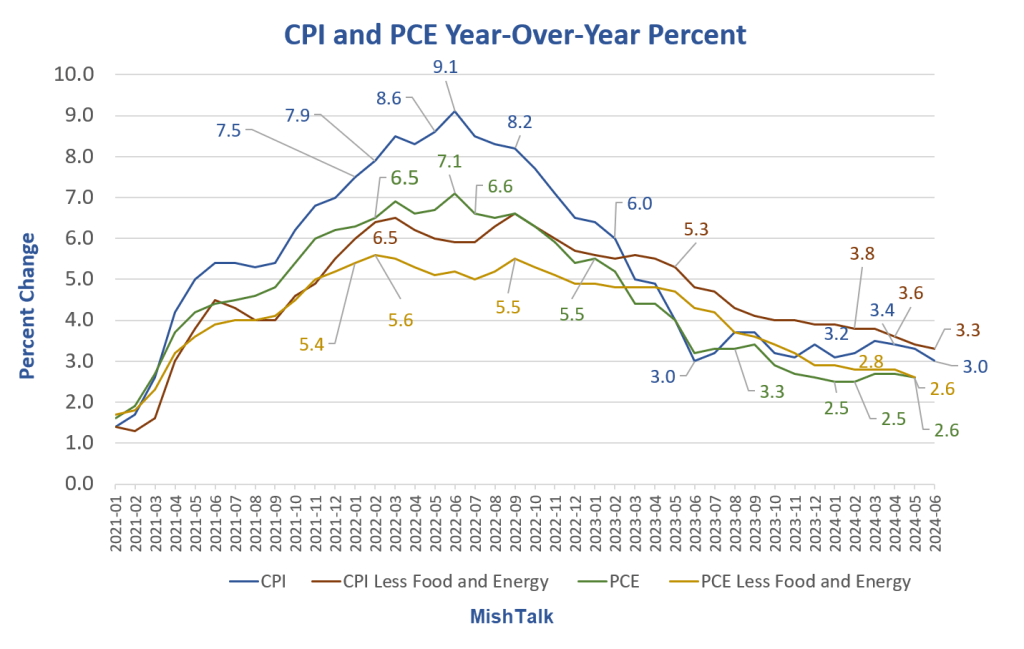
CPI vs PCE
Year-over-year the CPI is up 3.0 percent. Core CPI, excluding food and energy is up 3.3 percent.
PCE stands for Personal Consumption Expenditures. The PCE price index is the Fed’s preferred measure of inflation. PCE for June is not yet posted.
The major difference between the two indexes is CPI counts only those items directly paid by consumers. PCE counts indirect items such as Medicare and company health benefits.
As a result, the CPI overweighs shelter relative to PCE while PCE overweighs medical expenses relative to the CPI.
Flawed Measures
Neither the PCE nor CPI directly include the price of homes making a mockery of both indexes for anyone looking to buy.
Both indexes are very flawed, as I see it. Also ask anyone looing to buy a home, anyone who pays their own health care insurance, and anyone struggling with student debt.
The Fed defines stable as rising at a 0.2 percent pace, month after month. It’s ridiculous.
Looking Ahead
The economy is weakening. Energy and rent will put downward pressure on year-over-year inflation.
Food and medical are likely to put upward pressure on the CPI.
Since shelter is the most important component, so expect further moderation in the year-over-year numbers.
Decline in Year-Over-Year Inflation is Transitory
The short-term picture looks pretty good. But don’t expect miracles. Long term inflation pressures are immense.
Tariffs are inflationary. The budget deficit is inflationary. Medical care needs due to demographics are inflationary. The end of just-in-time manufacturing is inflationary. Onshoring is inflationary. The need for minerals for batteries is inflationary.
For years, the Fed had global wage arbitrage at their backs. That has ended and a strong gale of inflationary pressures is now blowing in the Fed’s face.
Recession Has Begun
On July 8, I stated Weak Data Says a Recession Has Already Started, Let’s Now Discuss When
Weakness Everywhere
There is weakness in housing (new home sales, existing home sales, and starts at the lowest in 4 years), consumer spending, manufacturing (both durable and nondurable good), jobs data (constant negative revisions, QCEW, major survey discrepancies, quits, and a rising unemployment rate), and finally we have major unexpected ISM Services in Contraction.
All of the above items are hard data other than the services ISM.
There is no savior on the horizon this time. The Fed rates to be inactive until it panics in September and that will be much too late to stop a recession that started in May or June.
The recession will cool energy and rent is cooling on its own.
For more details and discussion as to why I think a recession has started, please see the above link.
Near-term, the inflation outlook is good, but long-term isn’t. The Fed will struggle with this for a long time, and they won’t understand why.
